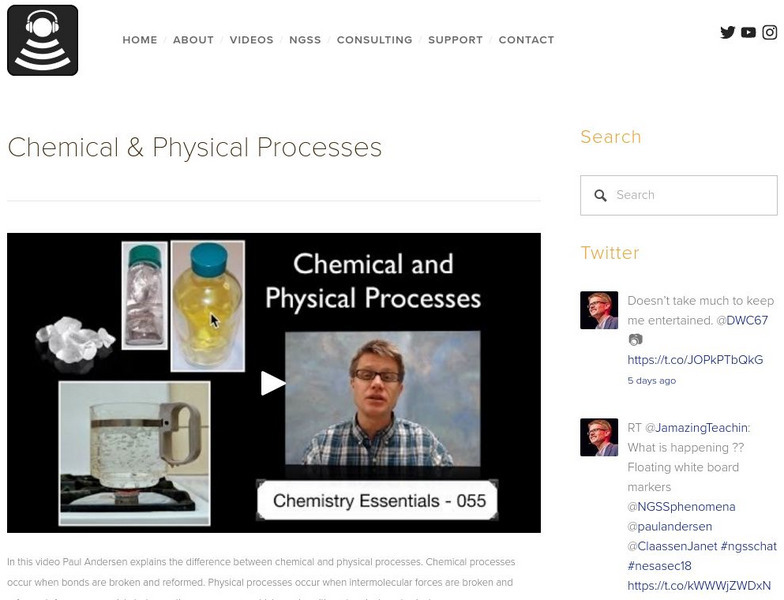Hi, what do you want to do?
Professor Dave Explains
IIT/JEE Chemistry Practice #19: Molecular Properties
Practice REAL problems from actual past IIT/JEE exams with Professor Dave!
Curated Video
Why Is Static Friction Greater Than Kinetic Friction?
Friction is the resistance that one object or surface experiences when moving over another object or surface. The two types of friction that come into play when moving two objects against one another are static and kinetic. Static...
msvgo
Behaviour of Real Gases
It explains the behaviour of real gases and their deviation from ideal gas behaviour(compressibility factor) It derives van der Waal's equation for real gases.
FuseSchool
Plasticisers & Hardeners
Learn the basics about plasticisers and hardeners, when learning about polymers as a part of the overall organic chemistry topic.
FuseSchool
What Are Intermolecular Forces
Learn what intermolecular forces are, the three most common types and the differences between them. An intermolecular force is simply an attractive force between neighbouring molecules. There are three common types of intermolecular...
Professor Dave Explains
Viscosity, Cohesive and Adhesive Forces, Surface Tension, and Capillary Action
Liquids have some very interesting properties, by virtue of the intermolecular forces they make, both between molecules of the liquid and those between the liquid and some other material they are in contact with. Let's learn about...
Socratica
Properties of Water: Hydrogen Bonding in Water
Water is life! How is one small molecule responsible for so many big things? Socratica's series on biology presents a fascinating look at the universal solvent. From its adhesive properties caused by hydrogen bonding to its ability to...
Socratica
Ionic and Covalent Bonds and Hydrogen Bonds
What determines the type of bond two atoms will form? Science scholars examine the factors that affect the formation of molecules and compounds through a short video from Socratica's biology series. Topics include valence electrons,...
Socratica
What Are Intermolecular Forces?
Johannes Diderik van der Waals won the Nobel Prize for physics in 1910. The video, part of the Socratica chemistry playlist, explains what the van der Waals forces are and how they interact based on type. It details dipole interactions...
Teacher's Pet
Liquids and Solids
What makes something a solid, liquid, or gas? Expand your class' understanding of the states of matter using an animated video. Young scientists explore the behavior of each of the states of matter in terms of temperature change,...
Fuse School
Intermolecular Forces
Investigate types of intermolecular forces through a video lesson. The instructor explains the concept of intermolecular forces and the three types. He includes several examples and illustrations of each.
Fuse School
Fractional Distillation
How do you untangle the hydrocarbon chains found in crude oil? The resource explains the process of fractional distillation, the method used to separate all of the useful molecules found in the world's most important nonrenewable...
Fuse School
Giant Chemical Structures - Part 1
Get them thinking big about chemistry! Young chemists learn about the large and elaborate structures created through covalent bonding in the fourth of a six-part video series regarding elements, mixtures, and compounds. The video covers...
TED-Ed
How Do Geckos Defy Gravity?
Geckos are reptilian superheroes, defying gravity to climb walls and hang from ceilings, but where did they get these amazing superpowers? Watch this fun video as it examines the amazingly designed feet of these unique animals and...
Educreations
Types of Solids
Young chemists discover that all solids are not created equal with the help of this short instructional video. Taking a microscopic look at matter, students learn how to classify solids based on the type of bonds that are responsible for...
Khan Academy
Khan Academy: Capillary Action and Why We See a Meniscus
A video introducing the intermolecular forces in water by exploring capillary action and the formation of a meniscus. Video will discuss the forces of adhesion and cohesion. [8:25]
Khan Academy
Khan Academy: Capillary Action and Why We See a Meniscus
See how capillary action and the meniscus are related to intermolecular forces in water. [8:26]
Khan Academy
Khan Academy: Boiling Points of Organic Compounds
Learn how to analyze the different boiling points of organic compounds using intermolecular forces. [11:07]
Khan Academy
Khan Academy: Biology: Chemistry of Life: Intermolecular Forces
Learn the basics about the forces between molecules called intermolecular forces in this video. [8:35]
Khan Academy
Khan Academy: Electronegativity: Electronegativity and Intermolecular Forces
Looks at how to discern whether molecules are polar or non-polar, and how to apply that polarity to intermolecular forces. [8:35]
Bozeman Science
Bozeman Science: Intermolecular Potential Energy
Find out the importance of intermolecular forces in chemistry. Intermolecular forces exist between dipoles (like hydrogen bonds), between dipoles and induced dipoles (like Ar and HCl) and between induced dipoles. The energy of the force...
Bozeman Science
Bozeman Science: Chemical and Physical Processes
In this video Paul Andersen explains the difference between chemical and physical processes. Chemical processes occur when bonds are broken and reformed. Physical processes occur when intermolecular forces are broken and reformed. A gray...
Crash Course
Crash Course Chemistry #26: Liquids
A crash course on London dispersion forces, hydrogen bonds, cohesion, adhesion, viscosity, capillary action, surface tension, and properties of liquids. [11:04]























